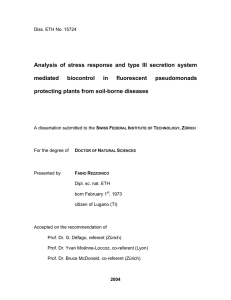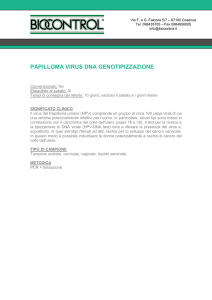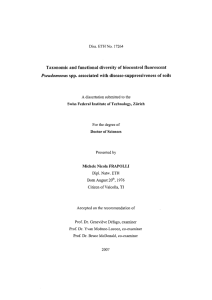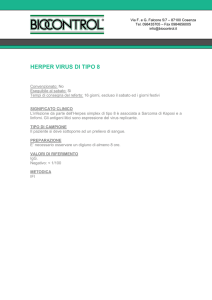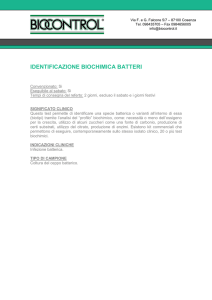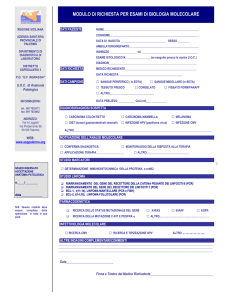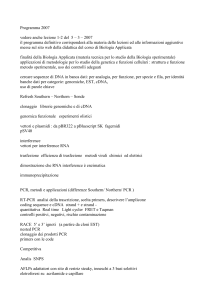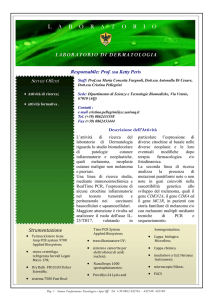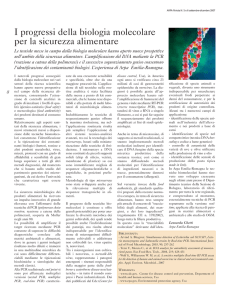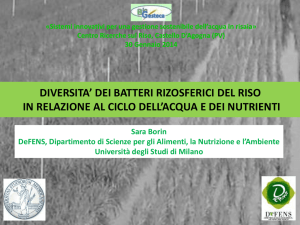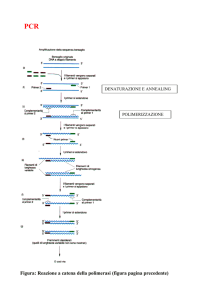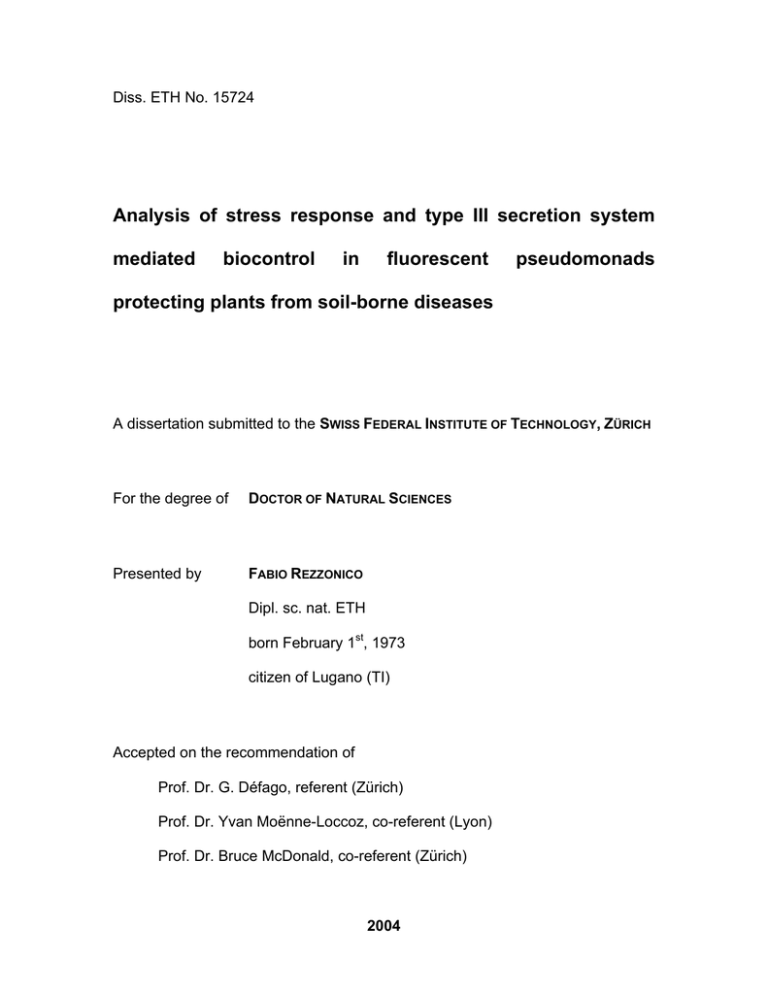
Diss. ETH No. 15724
Analysis of stress response and type III secretion system
mediated
biocontrol
in
fluorescent
pseudomonads
protecting plants from soil-borne diseases
A dissertation submitted to the SWISS FEDERAL INSTITUTE OF TECHNOLOGY, ZÜRICH
For the degree of
DOCTOR OF NATURAL SCIENCES
Presented by
FABIO REZZONICO
Dipl. sc. nat. ETH
born February 1st, 1973
citizen of Lugano (TI)
Accepted on the recommendation of
Prof. Dr. G. Défago, referent (Zürich)
Prof. Dr. Yvan Moënne-Loccoz, co-referent (Lyon)
Prof. Dr. Bruce McDonald, co-referent (Zürich)
2004
The great tragedy of science – the slaying of a beautiful
hypothesis by an ugly fact.
T. H. Huxley, Biogenesis and abiogenesis (1870)
TABLE OF CONTENTS
ABBREVIATIONS AND SYMBOLS
3
SUMMARY
5
RIASSUNTO
7
CHAPTER 1 - GENERAL INTRODUCTION
11
CHAPTER 2
57
Effect of stress on the performance of a phlA-based quantitative competitive PCR assay
to monitor biocontrol Pseudomonas fluorescens CHA0
CHAPTER 3
73
Comparison of ATPase-encoding type III secretion system gene hrcN in biocontrol
fluorescent pseudomonads and phytopathogenic proteobacteria
CHAPTER 4
107
Evolutionary recycling of phytopathology-related type III secretion system gene(s) leads
to development of beneficial plant-microbe interaction
CHAPTER 5 - GENERAL DISCUSSION
133
CHAPTER 6 - APPENDIX
151
Sequencing of type III secretion system genes of P. fluorescens KD downstream of hrcN
ADDENDUM
158
Annotated TTSS sequence of P. fluorescens KD
ACKNOWLEDGEMENTS
161
CURRICULUM VITAE
163
PUBLICATIONS
164
-1-
SUMMARY
The utilization of Pseudomonas strains as inoculants for biological control of
soilborne plant diseases offers a promising alternative solution to the application of
chemical pesticides, but their inconsistent performance under field conditions has
hindered a widespread commercialization. To overcome these problems, it is therefore
important to understand the ultimate fate of released bacteria in a stressful environment
such as natural soil and to fully comprehend the mechanisms involved in plant protection.
The purpose of this work was to analyze the physiological status and the traceability of
stressed Pseudomonas cells using a polymerase chain reaction (PCR) approach and to
study the potential role of the type III secretion system (TTSS) in biocontrol interactions.
In the first part, the effect of different types of abiotic stresses on the physiological
status of the bacteria was investigated and correlated with their enumerability by
quantitative competitive PCR (QC-PCR). Good statistical correlations were found
between QC-PCR and both culturable and total cell number when studying cells in fresh
laboratory cultures, but not when using stressed cultures containing viable but nonculturable cells (VBNC). In the latter case the amount of DNA detected by PCR was in
most cases higher than the one expected to be detected in colony forming units (CFUs)
alone. Conversely, this was found to be either higher or lower than the amount expected
in total cells enumerated by immunofluorescence, depending on the type of stress factor
applied. This suggests that different stresses affect DNA availability to PCR (hence also
to bacterial RNA polymerase) in different ways, producing distinct types of nonculturable cells. These factors make QC-PCR a method difficult to use for bacterial
quantification in environmental samples, but which may however enable to gain insight
about the physiological state of bacteria subjected to environmental stresses.
In the second part of this work, the presence of genes belonging to the TTSS was
studied among a well-characterized worldwide collection of biocontrol pseudomonads
using PCR and DNA hybridization. TTSS gene hrcN was found in about 60% of
biocontrol fluorescent pseudomonads studied, with no particular predilection for the
geographical origin of the strains, their different biocontrol ability or the plant species
-5-
from which they were originally isolated. The TTSS sequences found were analyzed to
establish the phylogenetic relationships among them and compared to those found in
plant pathogenic pseudomonads. Data were used to build a phylogenetic tree, which was
compared to the tree derived from 16S-rDNA sequences. The fact that 16S rDNA and
hrcN have followed a similar evolution points to the ancestral origin of TTSS both in
pathogenic and non-pathogenic strains. In the hrcN tree most biocontrol pseudomonads
clustered separately from their phytopathogenic counterparts, there were however few
exceptions suggesting that in some cases, e.g. in P. fluorescens KD, TTSS genes might
have experienced an horizontal gene transfer (HGT).
The impact of this HGT event on biological control was investigated in the third part
of this work, where the biocontrol performance of a hrcV mutant of KD against P.
ultimum in cucumber was compared with those of wildtype KD and found to be
significantly lower. This effect was not to ascribe to an altered cucumber root
colonization ability, which was unaffected in the mutant strain. In order to understand
which interactions are important for the activation of TTSS, the promoter region
controlling the hprJ-operon of P. fluorescens KD, which contains hrcV, was fused to an
inaZ reporter gene and its activity was measured both in vitro and in vivo in presence of
plant and pathogen. The expression of the hprJ’-inaZ reporter fusion was similar in nonsterile potting mix substratum and in the cucumber rhizosphere, but in both cases it was
significantly higher when P. ultimum was also present, especially in the rhizosphere. In
vitro, an increase in inaZ activity was observed when strain KD was cultivated in
presence of P. ultimum but not with wheat pathogen Gaeumannomyces graminis var.
tritici, against which KD shows no biocontrol activity. The effect on P. ultimum was
assessed in vitro by measuring the activity of fungal polygalacturonase (PGA), which is a
key pathogenicity enzyme for this fungus. When P. ultimum was confronted to P.
fluorescens KD, PGA production was delayed and enzyme levels were statistically lower.
In contrast, the hrcV– mutant KD-dork did not delay pectinase production in P. ultimum
and enzyme levels were statistically higher with KD-dork compared to KD. Taken
together, these results indicate that the expression of TTSS genes in P. fluorescens KD is
induced by the presence of the pathogen rather than the root, and they suggest that the
contribution of TTSS to the biocontrol activity of this strain targets the pathogen directly.
-6-
RIASSUNTO
Analisi della risposta allo stress e ruolo dell’apparato di secrezione delle proteine di
tipo III nell'attività di controllo biologico in batteri appartenenti al genere
Pseudomonas in grado di proteggere le piante da agenti patogeni residenti nel suolo.
L’utilizzo di ceppi batterici appartenenti al genere Pseudomonas quali agenti di
controllo biologico rappresenta una promettente alternativa all’uso di pesticidi chimici
per la protezione delle coltivazioni da agenti patogeni residenti nel suolo, ma la scarsa
efficacia della loro applicazione pratica su vasta scala ne ha per ora impedito una loro
estesa commercializzazione. Per risolvere questi problemi è perciò importante capire
quale è il destino dei batteri rilasciati nell’ambiente a questo scopo e quali sono i
meccanismi molecolari coinvolti nell’azione di biocontrollo. L’obiettivo di questo lavoro
è quello di analizzare le conseguenze degli stress ai quali sono sottoposti i batteri una
volta rilasciati nel suolo, con particolare attenzione all’analisi del loro stato fisiologico e
della loro reperibilità attraverso una tecnica basata sulla reazione a catena della
polimerasi (PCR), e lo studio del potenziale coinvolgimento dell’apparato di secrezione
delle proteine di tipo III (SS3) nell’attività di biocontrollo.
Nella prima parte di questo lavoro è stata studiata l’influenza di differenti tipi di stress
abiotici sullo stato fisiologico di Pseudomonas fluorescens CHA0. La PCR quantitativa
(QC-PCR) è stata utilizzata quale tecnica alternativa per la conta batterica. Una buona
correlazione statistica è stata trovata tra i risultati della QC-PCR, il numero di unità
formanti colonie (UFC) e il numero totale di cellule rilevate, quando questa tecnica è
stata applicata a colture batteriche cresciute in condizioni standard. Quando l’analisi è
stata estesa a colture di cellule vitali ma non coltivabili (VBNC, viable but non
culturable) sottoposte a differenti tipi di stress abiotici questa correlazione non è stata
riscontrata. La quantità di DNA rilevata mediante PCR è risultata, nella maggior parte dei
casi, più elevata rispetto a quella attesa nelle sole UFC e rispetto al conteggio delle
cellule totali al microscopio a immunofluorescenza è stata rilevata una maggiore o
minore quantità di DNA a in relazione al tipo di stress applicato.
-7-
Questo risultato porta ad ipotizzare che i differenti tipi di stress influenzino
diversamente la disponibilità del DNA batterico all’amplificazione durante la PCR (e
quindi, di riflesso, probabilmente anche alla RNA polimerasi batterica), producendo
tipologie di cellule vitali ma non coltivabili (VBNC) differenti tra loro.
In conclusione, la QC-PCR risulta un metodo di difficile applicazione per la
quantificazione dei batteri, ma può essere utilizzata per analizzare la reazione fisiologica
dei batteri agli stress ai quali sono sottoposti nel loro ambiente naturale.
Nella seconda parte di questo lavoro, una collezione di ceppi di Pseudomonas
provenienti da tutto il mondo con proprietà di biocontrollo, è stata studiata mediante PCR
ed ibridazione per verificare la presenza di geni appartenenti al SS3. Il gene hrcN,
codificante per una ATPasi del SS3, è stato trovato in circa 60% dei ceppi di
Pseudomonas studiati, indipendentemente dal loro luogo di provenienza, dalle proprietà
di biocontrollo espresse dal ceppo o dalla specie della pianta dalla quale erano stati
originalmente isolati.
Le sequenze hrcN trovate nei ceppi di biocontrollo sono state paragonate tra di loro
per determinare le relazioni filogenetiche e confrontate con sequenze appartenenti a ceppi
fitopatogeni. I dati ottenuti sono stati usati per costruire un albero filogenetico, che è stato
comparato a quello ottenuto utilizzando le sequenze dei geni codificanti per l’RNA
ribosomale (16S-rDNA).
Come nel caso dell’RNA ribosomale, la maggior parte dei ceppi Pseudomonas di
biocontrollo rappresentati nell’albero basato sulla sequenza di hrcN appartiene ad una
clade separata rispetto ai batteri fitopatogeni. Il fatto che entrambi i geni si siano evoluti
parallelamente suggerisce che vi sia un’origine ancestrale comune tra l’apparato di
secrezione dei ceppi saprofiti e quello dei ceppi patogeni. Alcune incongruenze tra i due
alberi filogenetici, come per esempio nel caso di P. fluorescens KD, suggeriscono però la
possibilità che un trasferimento orizzontale di geni del SS3 da saprofiti a patogeni possa
essere in alcuni casi avvenuto.
L’influsso del trasferimento e dell’acquisizione di geni appartenenti al SS3 sull’attività
di biocontrollo di P. fluorescens KD è stato studiato nella terza parte di questo lavoro,
con la creazione e l’analisi di un mutante nel gene hrcV. Questo mutante, denominato
KD-dork, ha dimostrato una minor efficacia rispetto al ceppo selvatico nel proteggere
-8-
piante di cetriolo (Cucumis sativus) dagli attacchi causati dal fungo Pythium ultimum,
agente eziologico della marcescenza delle radici (root rot), ma il minor biocontrollo non è
da ascrivere ad una inferiore capacità da parte del batterio di colonizzare le radici della
pianta. Allo scopo di analizzare quali sono le interazioni importanti per l’attivazione del
SS3 nel processo di biocontrollo, la regione promotrice dell’operone hrpJ (contentente
anche hrcV) è stata fusa a un gene reporter (inaZ), la cui attività è stata misurata sia in
vivo che in vitro in presenza di pianta e patogeno. L’espressione del costrutto si è rivelata
simile sia in substrato non sterile che nella rizosfera del cetriolo, aumentando
sensibilmente in entrambi i casi, ma in modo più accentuato nella rizosfera, nel caso di
presenza del patogeno P. ultimum. In vitro, un aumento dell’attività di inaZ è stato
osservato in presenza di P. ultimum ma non del patogeno del frumento Gaeumannomyces
graminis var. tritici contro il quale KD non mostra alcuna attività di biocontrollo.
L’effetto sulla patogenicità di P. ultimum è stato misurato in vitro analizzando la
produzione fungina di poligalacturonasi (PGA). Alla presenza di P. fluorescens KD la
produzione di PGA da parte di P. ultimum è ritardata e risulta statisticamente più bassa.
Al contrario, la presenza del mutante hrcV– KD-dork non ritarda la produzione di PGA da
parte del fungo e gli permette una produzione dell’enzima che è statisticamente più alta
rispetto al ceppo selvatico. Concludendo, questi risultati indicano come l’espressione dei
geni del SS3 in P. fluorescens KD sia indotta proprio dalla presenza del patogeno
piuttosto che da quella della pianta e della sua radice, e suggeriscono come probabilmente
sia proprio il fungo ad essere l’obiettivo diretto dell’attività del SS3 acquisito da KD.
-9-

